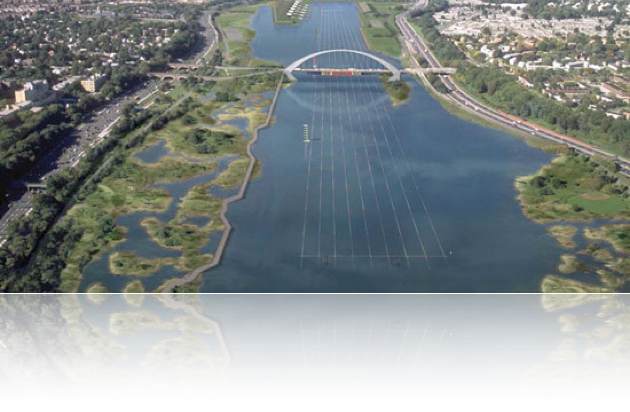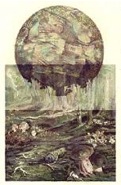Current and Recent
Projects
PF 1 – Urban Farm at PS1 Contemporary Arts Center
Working with Dan Wood and Amale Andraos and others at Work Architecture
Company, winners of this year’s MOMA PS1 Young Architects award, The Gaia
Institute participated in the creation of Public Farm 1 (PF 1). This productive
Urban Farm is located at the PS1 Contemporary Arts Center in Long Island City,
NY, growing on 65 cubic yards of GaiaSoil. This first-ever aerial Urban Farm is
built of florets of cylindrical cardboard concrete forms. Innovative design
used here shows how completely new forms can emerge from commonplace
construction materials. Ultra-lightweight GaiaSoil worked in this art form to
provide both optimal conditions as a growing medium for more than 50 plant
species and a greatly diminished mass for the construction itself to support.
Read more about the Urban
Farm and GaiaSoil.
El Jardín del Paraíso, Lower East Side, NY, NY
Humus-rich soils and native plant communities were restored in order to capture
storm water and re-establish natural cycles in a community garden in Manhattan.
Compost from New York City’s waste stream was used to establish soil buffers
and create wetlands to re-establish habitat while mitigating historic lead
contamination. In collaboration with the community gardeners who built El
Jardín del Paraíso on top of the urban rubble and fill of an old tenement
site, and in partnership with the NYC Department of Parks and Recreation, and
with the help of NYC Department of Environmental Protection, the Institute
carried out the design, development and construction of what is believed to be
the first biogeochemical cap and stormwater capture parkland in the New York
City region.
Over twenty years ago, the Gaia Institute developed the capacity to create
ultra-lightweight soil out of the waste stream in order to establish ecological
and agricultural systems on rooftops. Much further developed in recent years, a
patent was awarded in 2005 for this plant growth medium. A grant from the Bronx
Initiative in Energy and the Environment and the Bronx Overall Development
Corporation in the Bronx Borough President’s Office made it possible to build
an instrumented, stormwater capture and educational green roof facility in
partnership with St. Simon Stock School.
The Gaia Institute, with the Green Apple Corps from the New York City
Department of Parks & Recreation as well as St. Simon Stock faculty and
students, constructed a native plant community and urban vegetable garden on
top of the grammar school. After the roof membrane was installed and fully
tested for water holding capacity, our ultra-lightweight GaiaSoil was installed
and planted with a native meadow in June 2005. The finished green roof was
outfitted with a weather station, including rain gauge, heat sensors,
temperature, and humidity meters to aid in the educational program of the St.
Simon Stock school and to document the behavior of the first green roof in the
Bronx.
This urban stormwater capture system addresses urban code requirements by
constructing soil buffers and street-side plantings that are directly connected
with the standard storm drains on city streets. Because of this direct
connection, road and sidewalk drainage infrastructure moves stormwater directly
into contact with natural biological and geochemical filters and acts to hold
stormwater for plantings, and out of the combined sewer system. This project,
funded by Congressman José E. Serrano's Wildlife Conservation Society-National
Oceanic & Atmospheric Administration’s Lower Bronx River Partnership has
produced full scale plans to retrofit a twelve hundred foot length of roadway
in the Hunts Point district of the Bronx River Watershed.
Nugo Neu Corporation operates a six and a half acre recycling facility in Hunts
Point on the Bronx River. This industrial landscape is presently under
construction and modification to improve efficiencies of truck to barge
transfer as part of New York City’s solid waste management plan. In addition,
the facility also handles thousands of tons of metal each week. Hugo Neu is
working with the Gaia Institute to capture and treat all stormwater that is
generated from the site before it enters the Bronx River Estuary.
By creating a string of wetlands along the upland edge of the
facility, and surrounding the entire landscape with a stormwater treatment wall
to be populated with mosses and ferns, natural biogeochemical filters will be
established to improve water and air quality while greatly increasing
biodiversity in and around the facility and along a thousand feet of New York
City roadway. This green wall is designed to remove pollutants from stormwater
while increasing the aesthetics and biodiversity of an old industrial landscape
while adding value to the commercial and residential properties within a few
block radius of the Hugo Neu facility
The Bronx River, Pugsley and Westchester Creeks, Hutchinson River and Pelham
Bay Park contain the last remaining salt marsh in the southern and eastern
Bronx. The keystone species that create this critically important habitat
include salt marsh cordgrass, mussels, and fiddler crabs. Together, these
organisms increase the productivity and water filtration capacity of intertidal
habitat, and create homes and feeding grounds for more than a hundred species
in and around salt marsh systems.
By comparing a number of marshes that have been restored or planted very
recently, as well marshes next to large combined sewer outfalls, and
documenting the presence and density of plants, mussels, and fiddler crabs, it
is possible to determine how well the marshes are developing, and how much
impact these local marshes can have on sequestering local pollutant
inputs.
The tidal strait of what is now called the East River was long bordered on the
north and west by extensive eel grass and shellfish reefs and beds. The oysters
were harvested by colonists and, in the eastern Bronx, remained productive well
into the 19th Century. Nearby eelgrass supported thousands of brant and other
water fowl fed on the eelgrass, which provide habitat in an extensive fishery
in western Long Island Sound. Eel grass was ravaged by disease in the 1930s,
and seems to have all but disappeared by the 1950s. High nitrogen and increased
turbidity together acted to eliminate near-shore habitat for eel grass
thereafter. Increasing sewage discharge removed oxygen and habitat from much of
the waterways surrounding New York City and the Bronx, making life increasingly
impossible for any remaining oyster beds from the early 20th Century on.
Recent improvements in water quality and clarity have, however, in many places,
changed the prognosis for oyster reefs and eel grass ecosystems. In partnership
with the Hudson-Raritan BayKeeper, and with the New York City Department of
Parks and Recreation, the Gaia Institute is surveying nutrient inputs, sediment
quality, and flow regimes favorable to oyster reefs and eel grass beds, with an
aim to begin piloting the restoration of these keystone species in coming
growing seasons.
While New York City’s bid for the 2012 Olympics was not successful,
mitigation and restoration of the Meadow and Willow Lake system could, and
perhaps should, still be used to improve local and regional environmental
quality and biological diversity. The nutrient sources from the ancient
saltmarshes beneath the lakes will shunt superabundant nutrients into the lakes
far into the future, giving rise to the fishkills that have plagued the twin
lakes for years. At the same time, stormwater runoff and non-point pollutant
input from the Grand Central Parkway and Van Wyck Expressway provide a constant
input of non-point pollutants including nitrates and hydrocarbons.
The Gaia Institute program for capturing stormwater in native plantings in deep
soils while holding and treating water in wetlands constructed to create a
buffer around the lakes' edge would provide high quality and increased
quantities of water inputs to both increase throughput and flushing while
increasing the diversity and scale of wetlands and other natural filters.
Expert testimony on the Draft Environmental Impact Statement
Past Projects and
Presentations
-
-
-
•Development of
design specifications for flood control and stormwater capture adjacent to
the new administration building of the Poly Prep Country Day School,
Brooklyn, NY
-
•Ecological
engineering and stormwater capture design development for the Henry Hudson
Parkway, New York, NY
-
•Forest
restoration in Cunningham Park, Queens, NY
-
•Ecological
engineering and design development for Oakland Ravine, Queens,
NY
-
•Feasibility
study for biogeochemical acid mine drainage mitigation, South Stafford,
Vermont
-
•Ecological
infrastructure exhibit, New York, NY
-
•Creating
native wetland gardens for stormwater capture at the edge of the Hutchinson
River, Co-Op City, NY
-
•Upland soil
buffer and wetlands creation for stormwater treatment, East New York,
Brooklyn, NY
-
•Cleaning the
waters of Jamaica Bay
-
•Restoration
water quality monitoring of the Bronx River, Bronx, NY
-
•Great Swamp
ecological engineering, Dutchess County, NY
-
•Field
evaluations, laboratory analysis and expert testimony, Pine Tree Lake,
Monroe, NY
-
•Production of
annual reports on water quality monitoring for Bronx River Restoration,
Bronx, NY
-
•Expert
testimony: Orange County Landfill, Goshen, NY
-
•Crossing
Borders: Art and Ecology, Poland
-
•Expert
testimony for the City of New York, Canarsie Beach/Paerdegat Basin,
Brooklyn, NY
-
•Cost-Effective
Stormwater Treatment Utilizing Restored Wetlands
-
•Development of
the first infiltration-based flood and pollution control stormwater capture
system, Oakland Ravine, New York City
-
Selected
Presentations


